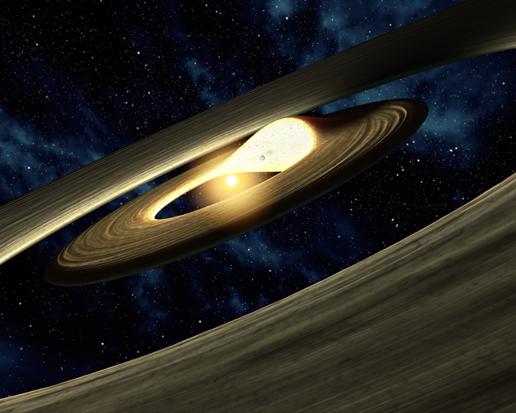The Spitzer Space Telescope, which takes photos at infrared frequencies, has located a cluster orbiting a young star, which will become a planet orbiting a star about a thousand light-years away from here

An artist's rendering showing how a clump of material in a protoplanetary disk spins. Astronomers used the Spitzer Space Telescope to discover evidence that a star's companion—whether it's another star or a planet—might push the planetary material into self-collapse, as depicted in this drawing.
Planets are born from a swirling disk of gas and dust. They can sculpt themselves lines or gaps inside the disc as they grow and fatten. The scientists used Spitzer's infrared vision to study the disc surrounding a star known as LRLL 31, located about a thousand light-years from Italeno in the region IC 348 in the Perseus group. Spitzer's new infrared observations reveal that the disk has both internal and external gaps.
Moreover, the data showed that infrared light from the disk changes over short periods of about a week - an unusual phenomenon. In particular, the light at different wavelengths oscillates back and forth, with the light at the short wavelengths increasing while the light at the long wavelengths is decreasing, and vice versa.
According to the astronomers, these changes may have been caused by the existence of a companion to the star (depicted as a planet in the picture). As the companion rotates on its axis, its gravitational pull on the wall of the inner disk causes it to contract into a clump. The clump itself will also spin around the star, and shadow a part of the outer disk. When the bright side of the clump is on the far side of the star, facing Earth, more infrared light in the lower wavelengths should be observable (hotter material closer to the star emits shorter wavelengths of the infrared). In addition, the shadow on the block may result in reduced emission of infrared light at longer wavelengths.
The opposite process occurs when the clump is in the foreground of the star and its bright side is hidden (shorter wavelengths decrease and longer wavelengths increase). This is exactly what Spitzer expected.
The size of the block and the planet are exaggerated here to illustrate the dynamics of the system.

10 תגובות
Here's what you asked for!
(^^^)
coral
The meaning of 1000 light years is the distance that light travels in a thousand years. It is clear that the greater the distance, the longer it takes for the light that hits the object being looked at to reach the eye!
It's that simple!
Proof: It takes less time to travel a small distance at a certain speed than to travel a large distance at the same speed.
: )
Oh Roy
Obviously, this is not something that everyone understands (maybe it is for you)
To a person who is not that familiar with the field, this will sound really strange, because when you look through a simple telescope, at the moon on an ordinary and casual night, for you, what you see right now is what is happening now, why do you know that the further away you look, the more things happened a long time ago More (I present this as a question to a person new to the field).
Just an explanation would also be helpful
I recommend, to those who have a free hour, to see and hear his lecture, which in my opinion is excellent by Dr. Eran Ofek, on the "Astronomy Club" website of Tel Aviv University, "From the formation of the moon to the eclipse of the moon". Recommended!
But since 1000 years of such activities in space is about a millionth of a second for you (if not a billion...), then the situation there should probably be quite similar today as well...
?????
Can you elaborate please?
Oh coral, coral...
Obviously - what you see in a telescope from a distance of 1,000 light years happened 1000 years ago.
But since 1000 years of such activities in space is about a millionth of a second for you (if not a billion...), then the situation there should probably be quite similar today as well...
Could it have happened a long time ago and we are only now able to see it?
We probably won't live to see it as a planet
Amazing!!! But there is a chance that this is only a small part of the puzzle... if at all.
Cool